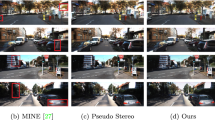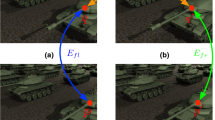Abstract
Typical stereo algorithms treat disparity estimation and view synthesis as two sequential procedures. In this paper, we consider stereo matching and view synthesis as two complementary components, and present a novel iterative refinement model for joint view synthesis and disparity refinement. To achieve the mutual promotion between view synthesis and disparity refinement, we apply two key strategies, disparity maps fusion and disparity-assisted plane sweep-based rendering (DAPSR). On the one hand, the disparity maps fusion strategy is applied to generate disparity map from synthesized view and input views. This strategy is able to detect and counteract disparity errors caused by potential artifacts from synthesized view. On the other hand, the DAPSR is used for view synthesis and updating, and is able to weaken the interpolation errors caused by outliers in the disparity maps. Experiments on Middlebury benchmarks demonstrate that by introducing the synthesized view, disparity errors due to large occluded region and large baseline are eliminated effectively and the synthesis quality is greatly improved.
Similar content being viewed by others
Explore related subjects
Discover the latest articles and news from researchers in related subjects, suggested using machine learning.References
Bleyer M, Rother C, Kohli P. Surface stereo with soft segmentation. In: Proceedings of the 2010 IEEE Conference on Computer Vision and Pattern Recognition. 2010, 1570–1577
Fickel G P, Jung C R, Malzbender T, Samadani R, Culbertson B. Stereo matching and view interpolation based on image domain triangulation. IEEE Transactions on Image Processing, 2013, 22(9): 3353–3365
Vogel C, Schindler K, Roth S. 3D scene flow estimation with a piecewise rigid scene model. International Journal of Computer Vision, 2015, 115(1): 1–28
Wu G, Masia B, Jarabo A, Zhang Y, Wang L, Dai Q, Chai T, Liu Y. Light field image processing: an overview. IEEE Journal of Selected Topics in Signal Processing, 2017, 11(7): 926–954
Wu G, Liu Y, Fang L, Dai Q, Chai T. Light field reconstruction using deep convolutional network on EPI and extended applications. IEEE Transactions on Pattern Analysis and Machine Intelligence, DOI:10.1109/TPAML.2018.2845393
Fehn C. Depth-image-based rendering (DIBR), compression, and transmission for a new approach on 3D-TV. In: Proceedings of SPIE Stereoscopic Displays and Virtual Reality Systems XI. 2004, 93–104
Hosni A, Rhemann C, Bleyer M, Rother C, Gelautz M. Fast costvolume filtering for visual correspondence and beyond. IEEE Transactions on Pattern Analysis and Machine Intelligence, 2013, 35(2): 504–511
Lee S, Lee J H, Lim J, Suh I H. Robust stereo matching using adaptive random walk with restart algorithm. Image and Vision Computing, 2015, 37(C): 1–11
Sun D, Roth S, Black M J. A quantitative analysis of current practices in optical flow estimation and the principles behind them. International Journal of Computer Vision, 2014, 106(2): 115–137
Kubota A, Smolic A, Magnor M, Tanimoto M, Chen T, Zhang C. Multiview imaging and 3DTV. IEEE Signal Processing Magazine, 2007, 24(6): 10–21
Stefanoski N, Wang O, Lang M, Greisen P, Heinzle S, Smolic A. Automatic view synthesis by image-domain-warping. IEEE Transactions on Image Processing, 2013, 22(9): 3329–3341
Tian D, Lai P L, Lopez P, Gomila C. View synthesis techniques for 3D video. In: Proceedings of Internatlbnal Society for Optics and Phontonics, Applications of Digital Image Processing XXXII. 2009, 7443: 74430T
Mori Y, Fukushima N, Yendo T, Fujii T, Tanimoto M. View generation with 3D warping using depth information for FTV. Signal Processing: Image Communication, 2009, 24(1–2): 65–72
Wanner S, Goldluecke B. Variational light field analysis for disparity estimation and super-resolution. IEEE Transactions on Pattern Analysis and Machine Intelligence, 2014, 36(3): 606–619
Zhang L, Zhang Y H, Huang H. Efficient variational light field view synthesis for making stereoscopic 3D images. Computer Graphics Forum. 2015, 7(34): 183–191
Zhang C, Li Z, Cheng Y, Cai R, Chao H, Rui Y. Meshstereo: a global stereo model with mesh alignment regularization for view interpolation. In: Proceedings of the IEEE International Conference on Computer Vision. 2015, 2057–2065
Kalantari N K, Wang T C, Ramamoorthi R. Learning-based view synthesis for light field cameras. ACM Transactions on Graphics, 2016, 35(6): 193
Scharstein D, Szeliski R. A taxonomy and evaluation of dense twoframe stereo correspondence algorithms. International Journal of Computer Vision, 2002, 47(1–3): 7–42
Kordelas G A, Alexiadis D S, Daras P, Izquierdo E. Enhanced disparity estimation in stereo images. Image and Vision Computing, 2015, 35: 31–49
Peng Y, Li G, Wang R, Wang W. Stereo matching with spaceconstrained cost aggregation and segmentation-based disparity refinement. In: Proceedings of International Society for Optics and Phoritonics, Three-Dimensional Image Processing, Measurement, and Applications. 2015, 9393: 939309
Zbontar J, LeCun Y. Stereo matching by training a convolutional neural network to compare image patches. Journal of Machine Learning Research, 2016, 17(1): 2287–2318
Luo W, Schwing A G, Urtasun R. Efficient deep learning for stereo matching. In: Proceedings of the IEEE Conference on Computer Vision and Pattern Recognition. 2016, 5695–5703
Mattoccia S, Viti M, Ries F. Near real-time fast bilateral stereo on the GPU. In: Proceedings of the 2011 IEEE Conference on Computer Vision and Pattern Recognition Workshops. 2011, 136–143
Mattoccia S, Giardino S, Gambini A. Accurate and efficient cost aggregation strategy for stereo correspondence based on approximated joint bilateral filtering. In: Proceedings of Asian Conference on Computer Vision. 2009, 371–380
Yoon K J, Kweon I S. Adaptive support-weight approach for correspondence search. IEEE Transactions on Pattern Analysis andMachine Intelligence, 2006, 28(4): 650–656
Kolmogorov V, Zabih R. Computing visual correspondence with occlusions using graph cuts. In: Proceedings of the 8th IEEE International Conference on Computer Vision. 2001, 508–515
Taniai T, Matsushita Y, Naemura T. Graph cut based continuous stereo matching using locally shared labels. In: Proceedings of the IEEE Conference on Computer Vision and Pattern Recognition. 2014, 1613–1620
Yang Q, Wang L, Yang R, Stewénius H, Nistér D. Stereo matching with color-weighted correlation, hierarchical belief propagation, and occlusion handling. IEEE Transactions on Pattern Analysis and Machine Intelligence, 2009, 31(3): 492–504
Guney F, Geiger A. Displets: resolving stereo ambiguities using object knowledge. In: Proceedings of the IEEE Conference on Computer Vision and Pattern Recognition. 2015, 4165–4175
Psota E T, Kowalczuk J, Mittek M, Perez L C. Map disparity estimation using hidden markov trees. In: Proceedings of the IEEE International Conference on Computer Vision. 2015, 2219–2227
Mozerov M G, Van de W J. Accurate stereo matching by two-step energy minimization. IEEE Transactions on Image Processing, 2015, 24(3): 1153–1163
Mei X, Sun X, Zhou M, Jiao S, Wang H, Zhang X. On building an accurate stereo matching system on graphics hardware. In: Proceedings of the IEEE Conference on Computer Vision Workshops. 2011, 467–474
Veksler O. Fast variable window for stereo correspondence using integral images. In: Proceedings of the IEEE Conference on Computer Vision and Pattern Recognition. 2003, 556–561
Klaus A, Sormann M, Karner K. Segment-based stereo matching using belief propagation and a self-adapting dissimilarity measure. In: Proceedings of the 18th International Conference on Pattern Recognition. 2006, 15–18
Vogel C, Schindler K, Roth S. 3D scene flow estimation with a rigid motion prior. In: Proceedings of the IEEE International Conference on Computer Vision. 2011, 1291–1298
Boykov Y, Veksler O, Zabih R. Fast approximate energy minimization via graph cuts. IEEE Transactions on Pattern Analysis and Machine Intelligence, 2001, 23(11): 1222–1239
Yang Q, Yang R, Davis J, Nistér D. Spatial-depth super resolution for range images. In: Proceedings of the IEEE Conference on Computer Vision and Pattern Recognition. 2007, 1–8
Boominathan V, Mitra K, Veeraraghavan A. Improving resolution and depth-of-field of light field cameras using a hybrid imaging system. In: Proceedings of the IEEE International Conference on Computational Photography. 2014, 1–10
Ma Z, He K, Wei Y, Sun J, Wu E. Constant time weighted median filtering for stereo matching and beyond. In: Proceedings of the IEEE International Conference on Computer Vision. 2013, 49–56
Zhang Q, Xu L, Jia J. 100+ times faster weighted median filter (WMF). In: Proceedings of the IEEE Conference on Computer Vision and Pattern Recognition. 2014, 2830–2837
Lin Z, Shum H Y. A geometric analysis of light field rendering. International Journal of Computer Vision, 2004, 58(2): 121–138
Scharstein D, Szeliski R. High-accuracy stereo depth maps using structured light. In: Proceedings of the IEEE Conference on Computer Vision and Pattern Recognition. 2003, 195–202
Scharstein D, Hirschmüller H, Kitajima Y, Krathwohl G, Nešić N, Wang X, Westling P. High-resolution stereo datasets with subpixelaccurate ground truth. In: Proceedings of German Conference on Pattern Recognition. 2014, 31–42
Acknowledgements
This work was supported by the National key foundation for exploring scientific instrument (2013YQ140517), the National Natural Science Foundation of China (Grant No. 61522111) and the Shenzhen Peacock Plan (KQTD20140630115140843).
Author information
Authors and Affiliations
Corresponding author
Additional information
Gaochang Wu received the BS and MS degrees in mechanical engineering from Northeastern University, China in 2013 and 2015, respectively. He is currently working toward PhD degree in control theory and control engineering in Northeastern University, China. His current research interests include data mining, signal analysis, image processing and computational photography.
Yipeng Li received the BS and MS degrees in electronic engineering from the Harbin Institute of Technology, China in 2003 and 2005, respectively and the PhD degree in electronic engineering from Tsinghua University, China in 2011. Since 2011, he has been a Research Associate with the Department of Automation, Tsinghua University. His current research interests include computer vision and data mining by using deep architecture networks.
Yuanhao Huang received the BS degree from the Peking University, China in 2002 and the PhD degree from the City University of Hong Kong, China in 2009. He was a research fellow in the Singapore- MIT Alliance for Research and Technology (SMART) in 2011. He is the expert of the Thousand Talents Plan (China), and the CEO of ORBBEC CO.,LTD. His research interests include optical measurement, computer vision and infrared technology.
Yebin Liu received the BE degree from Beijing University of Posts and Telecommunications, China in 2002 and the PhD degree from the Automation Department, Tsinghua University, China in 2009. He has been working as a research fellow at the computer graphics group of the Max Planck Institute for Informatik, Germany in 2010. He is currently an associate professor in Tsinghua University. His research areas include computer vision and computer graphics.
Electronic supplementary material
Rights and permissions
About this article
Cite this article
Wu, G., Li, Y., Huang, Y. et al. Joint view synthesis and disparity refinement for stereo matching. Front. Comput. Sci. 13, 1337–1352 (2019). https://doi.org/10.1007/s11704-018-8099-4
Received:
Accepted:
Published:
Issue Date:
DOI: https://doi.org/10.1007/s11704-018-8099-4




